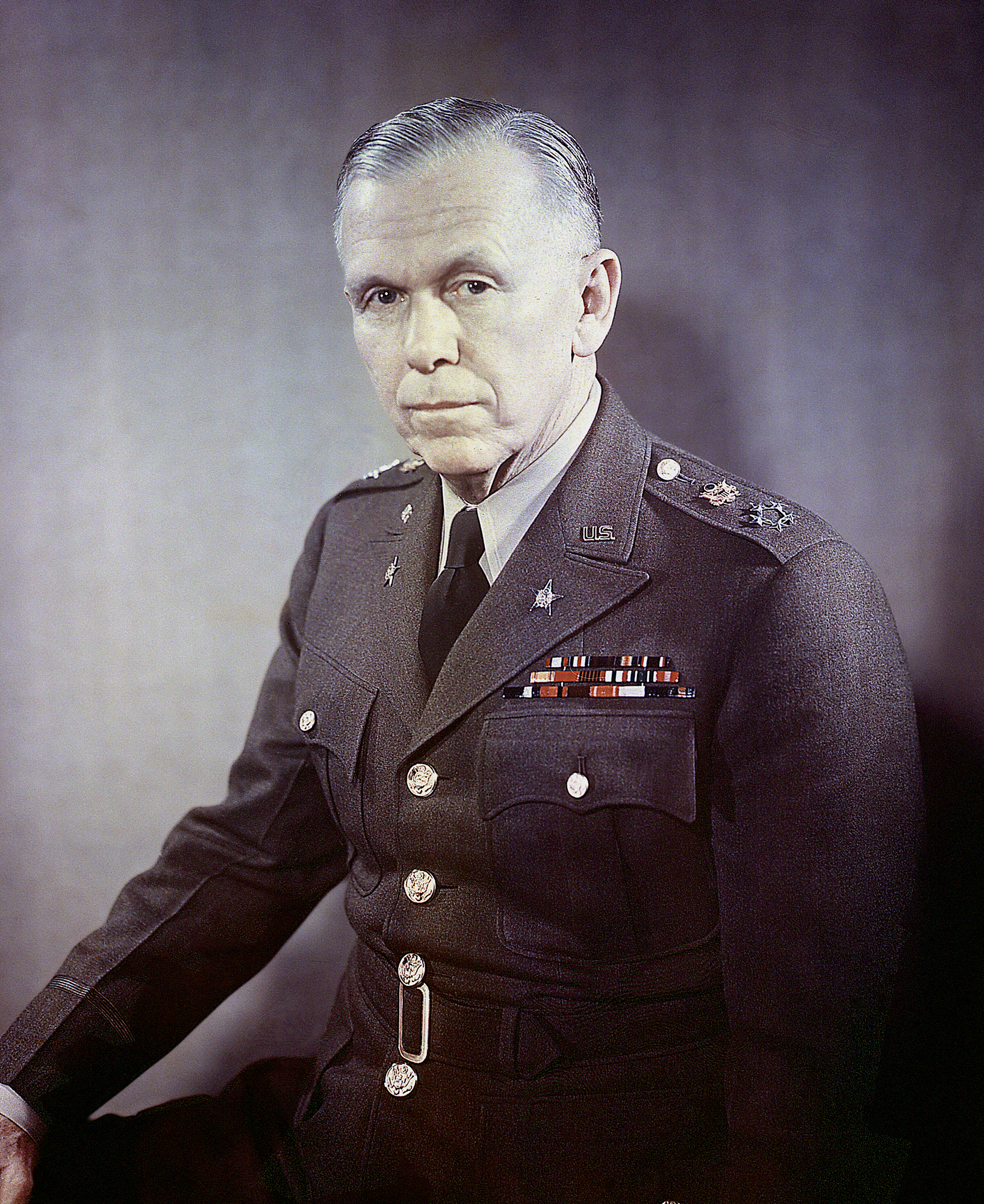Marshall, George Catlett (1880-1959), an American soldier and statesman, served as chief of staff of the United States Army during World War II (1939-1945). He also served as secretary of state from 1947 to 1949 and as secretary of defense in 1950 and 1951. Marshall was the first professional soldier to become secretary of state. In 1947, while serving in that post, he proposed the European Recovery Program, also called the Marshall Plan. Under this plan, the United States spent billions of dollars to rebuild war-torn western Europe. The Marshall Plan is credited with helping check the spread of Communism in Europe. Marshall’s role in European reconstruction earned him the 1953 Nobel Peace Prize.

His early life.
Marshall was born on Dec. 31, 1880, in Uniontown, Pennsylvania. His father owned coal and coke properties. The senior Marshall was extremely proud of his distant cousin John Marshall, former chief justice of the United States (see Marshall, John).
Marshall graduated from the Virginia Military Institute in Lexington, Virginia, in 1901. He was not an outstanding student, but he ranked in the upper half of his class. He received an army commission as a second lieutenant of infantry in 1902. Marshall married Elizabeth Carter Coles in 1902. She died in 1927, and Marshall married Katherine Tupper Brown in 1930.
His early career.
Marshall began his Army career in the Philippines in 1902. He returned home in 1903 and attended the Army School of the Line and the Army Staff College at Fort Leavenworth, Kansas. He graduated first in his class from the School of the Line. He said later of this achievement, “Ambition had set in.”
Assigned to the Philippines again in 1913, he showed great ability for planning and tactics in mock battles. In 1916, he returned to the United States and was promoted to captain. When the United States entered World War I in 1917, Marshall sailed for France with the first field units to go overseas. He served for a year as training officer and then as chief of operations of the First Division. He was transferred to the First Army in 1918 and served as chief of operations in the closing months of the war.
Marshall helped plan the First Army’s attack on St.-Mihiel. He directed the movement of more than 600,000 troops and 2,700 guns to the Meuse-Argonne front for the final American battle of the war. This transfer, made at night in less than two weeks following the St.-Mihiel offensive, completely surprised the Germans. General John J. Pershing, commander of the U.S. forces, hailed it as one of the great accomplishments of the war.
Marshall served as senior aide to Pershing from 1919 to 1924. From 1924 to 1927, he served in China as executive officer of the 15th Infantry Regiment.
From 1927 until 1932, Marshall was assistant commandant in charge of training at the Infantry School, Fort Benning (now Fort Moore), Georgia. He later helped organize and administer Civilian Conservation Corps (CCC) camps.
World War II.
Marshall was made a brigadier general in 1936. In 1938, he became chief of the war plans division of the War Department and then deputy chief of staff of the Army. On Sept. 1, 1939, the day World War II began, he became chief of staff of the U.S. Army, which then had fewer than 200,000 men, including the Army Air Corps. He also became a four-star general.
Marshall helped make the U.S. Army the greatest fighting force in history. He organized the Army into units trained to take part in desert, mountain, and jungle warfare. His work in Washington, D.C., was so important that he remained there throughout the war. He helped plan the overall war strategy. He was responsible for building, arming, and supplying a force of 8,250,000 soldiers and airmen. Under Marshall’s command, General Dwight D. Eisenhower and General Douglas MacArthur led American forces to victory in Europe and the Pacific.
On Dec. 16, 1944, Marshall became a General of the Army. In November 1945, a few months after the war ended, he retired as chief of staff. After he retired, President Harry S. Truman appointed him special representative to China. He spent much of the next year in China trying to end the civil war between the Chinese Nationalists and the Communists.
Statesman.
Marshall returned to the United States in January 1947, to assume the post of secretary of state in President Truman’s Cabinet. As secretary, he urged Congress to pass the European Recovery Program. Under the plan, the United States sent about $13 billion in aid to European countries. Marshall also worked to secure aid for Greece and Turkey and to supply food to West Berlin when the Communists blockaded that city. These programs and the Marshall Plan did much to check Communist influence in Europe (see Marshall Plan). Marshall also began negotiations that led to the North Atlantic Treaty Organization (NATO). In 1949, he resigned his Cabinet post because of poor health.
Marshall served as president of the American Red Cross in 1949 and 1950. When the Korean War began in 1950, Truman asked Marshall to head the Department of Defense. An act of Congress set aside the rule that the secretary of defense must be a civilian. Marshall helped build up the United Nations fighting forces in Korea. He resigned as secretary of defense in September 1951.
Marshall died on Oct. 16, 1959, and was buried at Arlington National Cemetery. In 1964, the George C. Marshall Research Library, containing his papers and souvenirs, opened in Lexington, Virginia.
See also Meuse-Argonne Offensive.
